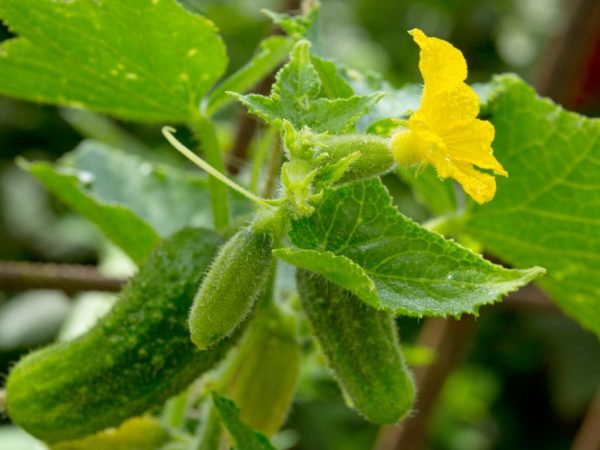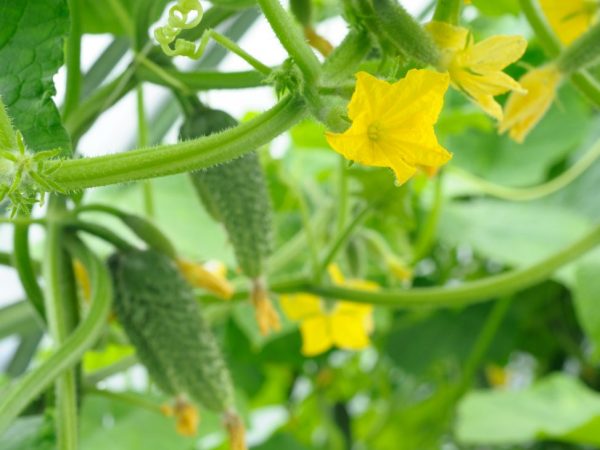Varieties of self-pollinated bunch cucumbers for greenhouses and fields
Tufted cucumbers are hybrids bred by breeders to increase the number of ovaries and the duration of fruiting. Bunch-type cucumbers grow in open ground and in heifers in the form of dense "bouquets". Large ovaries give good yields, and the bushes are unpretentious in care and watering.
- Features of self-pollinated cucumbers
- Differences between hybrids
- Growing rules
- Hybrid seeds and bushes
- Harvesting and disease
- Bunch cucumbers for open ground
- Variety of hybrids
- Style F1
- Sail F1
- Mother-in-law F1
- Bunch cucumbers for greenhouse conditions
- A variety of hybrids for a greenhouse
- Balcony F1
- Siberian garland
- Miracle bouquet

Varieties of self-pollinated bunch cucumbers for greenhouses and fields
A hanging garland will save space in a small greenhouse: the crop is suitable for year-round cultivation in favorable conditions. On open ground, the separated bushes germinate and bear fruit well.
Features of self-pollinated cucumbers
Self-pollinated cucumbers rarely get sick: breeders managed to breed a resistant hybrid. The number of ovaries and the quality of the harvest directly depends on the environmental conditions, the mode of the day (the amount of sunlight) and the quality indicators of the soil.
The "Landing" hybrid with a short ripening period gives the first harvest on day 38 (after transplanting). The fruits that are grown in the greenhouse are the most delicious - they are juicy and sweet. On one ovary, 4-5 fruits weighing up to 70 g are formed. The type of inflorescence is female.
Self-pollinated hybrids of Siberia are highly resistant to low temperatures. Variety "Detinets" bears fruit 45 days after planting of seedlings. The most persistent indeterminate hybrids have a medium ovary. The best self-pollinated varieties "Ocharovanie" or "Boy with a Thumb" are distinguished by high productivity: bushes planted in the open field yield up to 10-15 kg of cucumbers from 1 square meter of soil.
Differences between hybrids
Parthenocarpic hybrids belong to early maturing crops. In favorable conditions, the first harvest can be harvested already for 40-50 days. Several criteria will help to choose early crops:
- Bloom type. The female type of flowering hybrids allows the formation of up to 5 ovaries on one leaf. With this density, the fruits grow up to 12 cm in length.
- Landing type. Greenhouse hybrids are weaker. Crops grown outdoors give lower yields.
- The shape of the zelents, the degree of growth of the bushes. When choosing seeds, you should pay attention to the shape and dimensions of future fruits. Gherkins bear a lot, but the cucumbers themselves grow no more than 8 cm in length.
- Recharge and care. Parthenocarpic hybrids do not withstand severe drought, it is better to plant them in greenhouses, but the King of the Garden variety gets along well outdoors in a small shade with moderate watering.
Parthenocarpic and early varieties are suitable for growing on the balcony - the bushes bear fruit every two months and require minimal maintenance. Early varieties "Robin Hood" and "632 F1" are distinguished by undersized bushes.
The most plentiful first harvests, subsequent fruiting can degrade the quality of the cucumbers.Agricultural technology of hybrids allows you to choose a suitable hybrid that can be planted in the house, greenhouse or in the garden.
Growing rules
Due to the increased fruiting, planting and caring for the bush becomes more difficult. In order for the fruits to form, frequent watering and fertilizing of the soil is necessary.
A large area is allocated for super-beam seedlings: seedlings are planted at the rate of 4 stems per 1 sq. M. In the greenhouse, cucumbers with a bundle arrangement of ovaries are sown denser.
Hybrid seeds and bushes

The bush must be formed into one stem
Seeds for planting are bought: they cannot be removed from the crop on their own. Before planting in open ground, the seeds are fed with fertilizers so that the stems start growing faster. Bushes are formed from one stem (it will be well lit during the day).
It is necessary to "blind" 4 nodes of the main stem, and remove the remaining green shoots. One leaf will remain on the stem, from which the ovaries will appear. After the first harvest, the root system of the stem is fed with nitrogen fertilizers. Mineral dressing is best done once a week.
Harvesting and disease
Ripe fruits are harvested immediately: they make the stem heavier and it can break. Cucumbers can hang on the bush for a long time, but they quickly lose moisture and begin to taste bitter. Harvested every two days. The faster the crop is harvested, the faster the new one will ripen.
If the stem gets sick, it is treated with antiseptics and diseased shoots are removed. From fungi, the bushes are treated with a natural substance - milk whey.
Bunch cucumbers for open ground
Bunch cucumbers for open field are highly resistant to cold and drought. For open land plots, regular watering is organized. The soil is fertilized before planting the seedlings. Bunch cucumbers get along well in the shade, with minimal watering.
Bunch varieties of cucumbers for open ground belong to early ripening highly branched hybrids. For good fruiting of bushes outdoors, bees are not needed, so such bushes can be grown in any region.
Variety of hybrids
The presence of 5-6 green cucumber varieties with a bundle ovary does not guarantee a good harvest. The culture needs timely watering and care. Self-pollinating varieties eliminate the presence of bees for pollination and can be grown at any time.
Cucumber varieties with bunched ovary for open field:
- Mels;
- "Manul";
- "Little Son";
- "Zyatek".
The choice of varieties of cucumbers with a bundle ovary depends on the size of the land plot, the season and the quality of the crop that the gardener expects.
The "City Gardener" imported from Europe combines a high level of fruiting and a minimum ripening period. Universal bunch cucumbers ripen from 30 to 40 days. Cucumbers with bunched ovary from open ground or garden beds are suitable for making marinades, winter twists and salads.
Style F1

The fruits can be consumed in any form
Medium early hybrid variety suitable for open field planting. Ripe fruits are used to prepare salads and pickles for the winter. Zelentsy "Style" are elongated and neat: the length of each varies from 9 to 11 cm.
The growing period of the crop is average, and the fruiting period is lower than high. The bush gives a stable good harvest in late autumn.
Sail F1
The high-yielding variety "Parus F1" is resistant to temperature extremes and is planted on open land plots. The average yield of one full-fledged bush is 5 kg.
Black pubescence indicates the versatility of vegetables: they are used for making salads and marinades. The fruits are distinguished by a sweetish delicate taste.
Mother-in-law F1
A variety with good fruiting: the bushes are distinguished by resistance to low temperatures. In favorable conditions, "Mother-in-law F1" bears fruit until August. Harvesting bushes are dotted with weighty green plants - up to 13 cm each.
The taste of the fruit is sweet, the core is dense.Harvesting bushes are located in partial shade: drought leads to a deterioration in the quality of the crop.
Bunch cucumbers for greenhouse conditions
Parthenocarpic cucumbers are suitable for greenhouses. Disease-resistant cucumber varieties are grown in cramped circumstances and yield good yields. Greenhouse salad crops do not have pronounced thorns. The resulting fruits are well transported and peeled. For greenhouses, varieties of bunch cucumbers with a high content of sugar and peptides are suitable. Cucumbers are suitable for pickles and marinades. Such bushes are first generation hybrids.
To grow a good crop in a greenhouse, you will need frequent watering. Seeds of bundled cucumbers are pre-soaked in purchased solutions with active beneficial bacteria. Fertilization of the topsoil is carried out before planting the seeds. In a greenhouse, seedlings can not be transplanted, but the seeds can be grown on beds prepared for bushes.
A variety of hybrids for a greenhouse
For closed fertilized soil, universal hybrids of long-term fruiting are suitable. Such crops ripen not earlier than 40-50 days. The number of ovaries on one leaf does not exceed 4-5 flowers. The quality of the soil in the greenhouse determines the fruiting - the more fertilizer is in the soil, the more ovaries will appear. With such a description, it is easier to choose a hybrid suitable for pickles.
Multi-bunch bushes, on which greens appear no more than 8 cm in size, have wide foliage. The most prolific greenhouse hybrids:
- "Red mullet";
- "Robin the Hood";
- "Our Masha";
- "Dwarf".
The selected type of bouquet bush takes up little space and is suitable for growing on a balcony or in a greenhouse. Tufted ovaries do not develop into greens too quickly, so the crop does not stagnate for a long time on the bushes and draws juices from the stem.
Bunch cucumbers are profitable hybrids that give a large yield due to bunch ovaries (3-4 for each leaf). Several greens are present on the lash at once, unlike ordinary cucumber bushes. Ripe vegetables disperse on the sides and look like a New Year's garland. Tufted cucumbers are sold with the f1 mark, which characterizes resistant hybrid crops. Self-bred seeds lose the varietal qualities of the hybrid.
Balcony F1
Hybrid type gherkins with weak branching. Characteristic features of "Balcony F1": long-term fruiting and bunches with 4-8 ovaries on each leaf.
The determinant plant is suitable for growing in open soil or on a balcony (no drafts or wind blows). The heat-loving plant gets along well on an open loggia and bears fruit before the arrival of frost.
Siberian garland
The new variety "Siberian Garland" is distinguished by high fruiting and the ability to quickly adapt. Cucumbers of this type are super tough. In the greenhouse and outside the greenhouse "Siberian Garland" gives a stable, good harvest.
On bushes with 4-5 ovaries, up to 15 kg of fruits grow. The relatively low price of this type and durability sets it apart from other bunch cucumbers.
Miracle bouquet
As a result of many years of selection, the "Miracle Bouquet F1" was bred. The bushes are unpretentious and fruitful. Produces a stable harvest in hot and cold weather. Suitable for planting in regions with frequent rains - the fruits do not burst or become watery.
Any conditions are suitable for a bouquet hybrid - greenhouse or outdoors. With the arrangement of bushes in greenhouses, the fruiting period increases.


